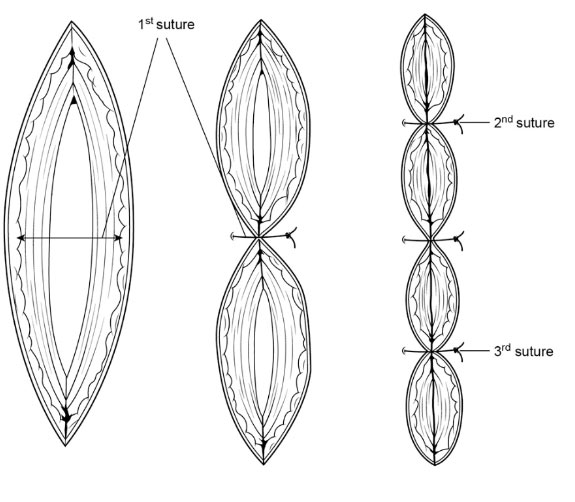Usually, excisional wounds are created with an ellipse: where the length of the wound is about 2-4 times longer than the width. This allows the wound to be closed without “bunching” of the ends.
When closing these elliptical wounds, the initial suture is usually placed in the middle, widest and most difficult portion of the wound to close. This is known as the rule of halves:
 Diagram of rule of halves
Diagram of rule of halves It is well-known to surgeons that the initial suture is under more tension than subsequent sutures. However, how much more force does the middle suture bear than the “2nd and 3rd sutures”? Myself and two colleagues sought to answer that question. We took elliptical wounds of the trunk and measured the initial force required to close the middle of the wound. Then, we measured the force required for the next two sutures. We discovered that the initial suture bears over five times more force than either of the subsequent two sutures. In many cases, we had difficulty even measuring the small forces involved in sutures placed after the initial suture. We went on to then place and measure tensions of sutures placed after the third suture, but all the forces were all too small for our tensiometer to measure.
This has implications for wound closure, in that the initial, middle suture or staple used to close the wound bears the majority of the wound tension.
Given this data, we are very excited by our initial results with the HEMIGARD™ adhesive retention suture device. The amount of force that can be used to close a wound is often limited by the strength of the skin itself. The HEMIGARD™ allows large tension suture to be used as the initial suture to get wound closure. Once the skin is apposed with one or more pairs of HEMIGARD™, the rest of the wound can be closed with very low tension sutures in a multitude of ways.
For example, we recently had a 3.0 cm wide forehead wound that could not be approximated.
HEMIGARD™ adhesive retention suture device to close a large forehead wound under tension.
We used a HEMIGARD™ to bolster the skin on each side of the wound, then used a 0 nylon (THICK) suture to get the edges touching. This HEMIGARD™ and the suture are bearing all that middle (1st suture) tension. This allowed us to perform a standard elliptical excision rather than a flap or graft. The rest of the wound, consistent with our study, was under minimal tension so could be closed with 5-0 (thin and delicate) absorbable sutures and then steri-strips on top. At one week post-op, there was a small imprint from the HEMIGARD™, but otherwise excellent healing. The patient noted that the “tight” feeling subsided in first day or so after surgery.
We use the HEMIGARD™ routinely to close a wide range of wounds of the legs, arms and face in which the thickness and strength of the skin is limiting our ability to use a high-tension suture. How can the HEMIGARD™ help you? Register for a HEMIGARD sample here.